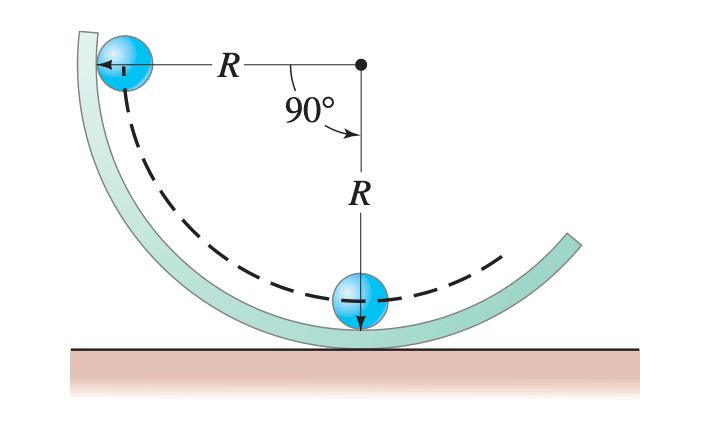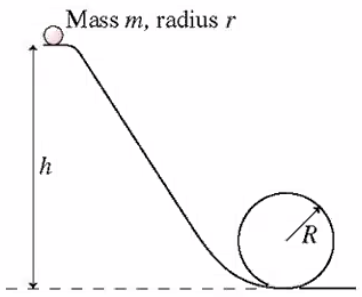0 attempts
0% avg
UBQ Credits
Part (a): Drawing a Free Body Diagram (FBD)
For the purposes of this explanation, drawing of the FBD is described:
– The ladder rests against a wall with length [katex] L [/katex] and weight [katex] W = 50 \, \text{N} [/katex].
– [katex] F_N [/katex] represents the normal force exerted by the wall on the ladder, acting horizontally at the top of the ladder.
– [katex] F_f [/katex] is the frictional force at the base of the ladder, which opposes the sliding movement, acting horizontally towards the wall.
– [katex] N [/katex] stands for the normal force exerted by the ground on the ladder, vertically upwards.
– [katex] W [/katex] is the weight of the ladder acting downwards from its center of mass.
Part (b): Finding the Minimum Angle [katex]\theta_{\text{min}}[/katex] so the Ladder Does Not Slip
| Step | Derivation/Formula | Reasoning |
|---|---|---|
| 1 | [katex] \text{Sum of horizontal forces: } F_N = F_f [/katex] | The normal force [katex] F_N [/katex] exerted by the wall is balanced by the frictional force [katex] F_f [/katex] at the base, since there is no other horizontal motion. |
| 2 | [katex] \text{Sum of vertical forces: } N = W [/katex] | The normal force [katex] N [/katex] from the ground balances the gravitational force [katex] W [/katex] because there is no vertical motion. |
| 3 | [katex] F_f = \mu N [/katex] | The frictional force [katex] F_f [/katex] can be expressed as the product of the coefficient of static friction [katex] \mu [/katex] and the normal force [katex] N [/katex]. |
| 4 | [katex] \text{Torque about point at base of ladder: } \\ W \frac{L}{2} \cos(\theta) = F_N L \sin(\theta) [/katex] | Taking torque about the base, counterclockwise torques due to the wall’s normal force [katex] F_N [/katex] should balance the clockwise torque due to the weight [katex] W [/katex]. The distance from the base to the CM is [katex] \frac{L}{2} [/katex]. |
| 5 | [katex] \frac{W}{2} = F_N \tan(\theta) [/katex] | Further simplification. |
| 6 | [katex] \frac{W}{2} = \mu W \tan(\theta) [/katex] | Replace [katex] F_N [/katex] with [katex] \mu N [/katex] as solved for in step 3, since [katex] F_N = F_f [/katex] as described in step 1. |
| 7 | [katex] \tan(\theta) = \frac{1}{2\mu} [/katex] | Simplify further by canceling out [katex] W [/katex] and isolating [katex]\theta [/katex]. |
| 8 | [katex] \theta = \tan^{-1}(\frac{1}{2\mu}) [/katex] | Finally, take the inverse tan to find [katex] \theta [/katex]. |
| 9 | [katex] \theta = \tan^{-1}(\frac{1}{2 \times .4}) [/katex] | Substitute [katex] \mu = 0.4 [/katex] into the equation derived. |
| 10 | [katex] \theta = \tan^{-1}(0.8) \approx 51.34^\circ [/katex] | This is the minimum angle to ensure the ladder does not slip. Calculate [katex] \theta [/katex] in degrees. |
| 11 | [katex] \boxed{\theta_{\text{min}} \approx 51.34^\circ} [/katex] | Final answer. |
Just ask: "Help me solve this problem."

A ball of radius \( r \) rolls on the inside of a circular track of radius \( R \). If the ball starts from rest at the left vertical edge of the track, what will be its speed when it reaches the lowest point of the track, rolling without slipping?
The driver of a car traveling at \( 30.0 \) \( \text{m/s} \) applies the brakes and undergoes a constant negative acceleration of \( 2.00 \) \( \text{m/s}^2 \). How many revolutions does each tire make before the car comes to a stop, assuming that the car does not skid and that the tires have radii of \( 0.300 \) \( \text{m} \)?

In the figure above, the marble rolls down the track and around a loop-the-loop of radius \( R \). The marble has mass \( m \) and radius \( r \). What minimum height \( h_{min} \) must the track have for the marble to make it around the loop-the-loop without falling off? Express your answer in terms of the variables \( R \) and \( r \).
A disk of known radius and rotational inertia can rotate without friction in a horizontal plane around its fixed central axis. The disk has a cord of negligible mass wrapped around its edge. The disk is initially at rest, and the cord can be pulled to make the disk rotate. Which of the following procedures would best determine the relationship between applied torque and the resulting change in angular momentum of the disk?
A boy and a girl are balanced on a massless seesaw. The boy has a mass of 60 kg and the girl’s mass is 50 kg. If the boy sits 1.5 m from the pivot point on one side of the seesaw, where must the girl sit on the other side for equilibrium?
By continuing you (1) agree to our Terms of Sale and Terms of Use and (2) consent to sharing your IP and browser information used by this site’s security protocols as outlined in our Privacy Policy.
| Kinematics | Forces |
|---|---|
| \(\Delta x = v_i t + \frac{1}{2} at^2\) | \(F = ma\) |
| \(v = v_i + at\) | \(F_g = \frac{G m_1 m_2}{r^2}\) |
| \(v^2 = v_i^2 + 2a \Delta x\) | \(f = \mu N\) |
| \(\Delta x = \frac{v_i + v}{2} t\) | \(F_s =-kx\) |
| \(v^2 = v_f^2 \,-\, 2a \Delta x\) |
| Circular Motion | Energy |
|---|---|
| \(F_c = \frac{mv^2}{r}\) | \(KE = \frac{1}{2} mv^2\) |
| \(a_c = \frac{v^2}{r}\) | \(PE = mgh\) |
| \(T = 2\pi \sqrt{\frac{r}{g}}\) | \(KE_i + PE_i = KE_f + PE_f\) |
| \(W = Fd \cos\theta\) |
| Momentum | Torque and Rotations |
|---|---|
| \(p = mv\) | \(\tau = r \cdot F \cdot \sin(\theta)\) |
| \(J = \Delta p\) | \(I = \sum mr^2\) |
| \(p_i = p_f\) | \(L = I \cdot \omega\) |
| Simple Harmonic Motion | Fluids |
|---|---|
| \(F = -kx\) | \(P = \frac{F}{A}\) |
| \(T = 2\pi \sqrt{\frac{l}{g}}\) | \(P_{\text{total}} = P_{\text{atm}} + \rho gh\) |
| \(T = 2\pi \sqrt{\frac{m}{k}}\) | \(Q = Av\) |
| \(x(t) = A \cos(\omega t + \phi)\) | \(F_b = \rho V g\) |
| \(a = -\omega^2 x\) | \(A_1v_1 = A_2v_2\) |
| Constant | Description |
|---|---|
| [katex]g[/katex] | Acceleration due to gravity, typically [katex]9.8 , \text{m/s}^2[/katex] on Earth’s surface |
| [katex]G[/katex] | Universal Gravitational Constant, [katex]6.674 \times 10^{-11} , \text{N} \cdot \text{m}^2/\text{kg}^2[/katex] |
| [katex]\mu_k[/katex] and [katex]\mu_s[/katex] | Coefficients of kinetic ([katex]\mu_k[/katex]) and static ([katex]\mu_s[/katex]) friction, dimensionless. Static friction ([katex]\mu_s[/katex]) is usually greater than kinetic friction ([katex]\mu_k[/katex]) as it resists the start of motion. |
| [katex]k[/katex] | Spring constant, in [katex]\text{N/m}[/katex] |
| [katex] M_E = 5.972 \times 10^{24} , \text{kg} [/katex] | Mass of the Earth |
| [katex] M_M = 7.348 \times 10^{22} , \text{kg} [/katex] | Mass of the Moon |
| [katex] M_M = 1.989 \times 10^{30} , \text{kg} [/katex] | Mass of the Sun |
| Variable | SI Unit |
|---|---|
| [katex]s[/katex] (Displacement) | [katex]\text{meters (m)}[/katex] |
| [katex]v[/katex] (Velocity) | [katex]\text{meters per second (m/s)}[/katex] |
| [katex]a[/katex] (Acceleration) | [katex]\text{meters per second squared (m/s}^2\text{)}[/katex] |
| [katex]t[/katex] (Time) | [katex]\text{seconds (s)}[/katex] |
| [katex]m[/katex] (Mass) | [katex]\text{kilograms (kg)}[/katex] |
| Variable | Derived SI Unit |
|---|---|
| [katex]F[/katex] (Force) | [katex]\text{newtons (N)}[/katex] |
| [katex]E[/katex], [katex]PE[/katex], [katex]KE[/katex] (Energy, Potential Energy, Kinetic Energy) | [katex]\text{joules (J)}[/katex] |
| [katex]P[/katex] (Power) | [katex]\text{watts (W)}[/katex] |
| [katex]p[/katex] (Momentum) | [katex]\text{kilogram meters per second (kgm/s)}[/katex] |
| [katex]\omega[/katex] (Angular Velocity) | [katex]\text{radians per second (rad/s)}[/katex] |
| [katex]\tau[/katex] (Torque) | [katex]\text{newton meters (Nm)}[/katex] |
| [katex]I[/katex] (Moment of Inertia) | [katex]\text{kilogram meter squared (kgm}^2\text{)}[/katex] |
| [katex]f[/katex] (Frequency) | [katex]\text{hertz (Hz)}[/katex] |
General Metric Conversion Chart
Example of using unit analysis: Convert 5 kilometers to millimeters.
Start with the given measurement: [katex]\text{5 km}[/katex]
Use the conversion factors for kilometers to meters and meters to millimeters: [katex]\text{5 km} \times \frac{10^3 \, \text{m}}{1 \, \text{km}} \times \frac{10^3 \, \text{mm}}{1 \, \text{m}}[/katex]
Perform the multiplication: [katex]\text{5 km} \times \frac{10^3 \, \text{m}}{1 \, \text{km}} \times \frac{10^3 \, \text{mm}}{1 \, \text{m}} = 5 \times 10^3 \times 10^3 \, \text{mm}[/katex]
Simplify to get the final answer: [katex]\boxed{5 \times 10^6 \, \text{mm}}[/katex]
Prefix | Symbol | Power of Ten | Equivalent |
|---|---|---|---|
Pico- | p | [katex]10^{-12}[/katex] | 0.000000000001 |
Nano- | n | [katex]10^{-9}[/katex] | 0.000000001 |
Micro- | µ | [katex]10^{-6}[/katex] | 0.000001 |
Milli- | m | [katex]10^{-3}[/katex] | 0.001 |
Centi- | c | [katex]10^{-2}[/katex] | 0.01 |
Deci- | d | [katex]10^{-1}[/katex] | 0.1 |
(Base unit) | – | [katex]10^{0}[/katex] | 1 |
Deca- or Deka- | da | [katex]10^{1}[/katex] | 10 |
Hecto- | h | [katex]10^{2}[/katex] | 100 |
Kilo- | k | [katex]10^{3}[/katex] | 1,000 |
Mega- | M | [katex]10^{6}[/katex] | 1,000,000 |
Giga- | G | [katex]10^{9}[/katex] | 1,000,000,000 |
Tera- | T | [katex]10^{12}[/katex] | 1,000,000,000,000 |
The most advanced version of Phy. 50% off, for early supporters. Prices increase soon.
per month
Billed Monthly. Cancel Anytime.
Trial –> Phy Pro
Try our free calculator to see what you need to get a 5 on the upcoming AP Physics 1 exam.
A quick explanation
Credits are used to grade your FRQs and GQs. Pro users get unlimited credits.
Submitting counts as 1 attempt.
Viewing answers or explanations count as a failed attempts.
Phy gives partial credit if needed
MCQs and GQs are are 1 point each. FRQs will state points for each part.
Phy customizes problem explanations based on what you struggle with. Just hit the explanation button to see.
Understand you mistakes quicker.

Phy automatically provides feedback so you can improve your responses.
10 Free Credits To Get You Started

By continuing you agree to nerd-notes.com Terms of Service, Privacy Policy, and our usage of user data.
NEW! PHY instantly solves any question
🔥 Elite Members get up to 30% off Physics Tutoring
🧠 Learning Physics this summer? Try our free course.
🎯 Need exam style practice questions? We’ve got over 2000.